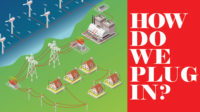Rising US Project Costs Challenge Renewable Energy Commitments

Giant components of the first 13-MW GE Haliade-X offshore wind turbine to be built at the Vineyard Wind project off Massachusetts, America's first and largest utility scale facility. leaves a state port on a feeder barge for transport to the site, about 65 miles away.
Photo courtesy of Vineyard Wind.
Even with cost bumps in U.S. offshore wind power construction causing new impacts to projects and developers, actions by some traditional energy sector firms in recent weeks indicate continuing commitment to their transition to renewables.
Virginia-based Dominion Energy said it would sell to Canadian pipeline operator Enbridge its three U.S. natural gas companies for $14 billion, a move that would make the buyer the largest gas utility by volume in North America. Dominion said the move comes amid an ongoing business review to boost its stock value, which has dropped by more than 40% since last September.
The utility also is developer of the mammoth 2.6-GW Coastal Virginia Offshore Wind project, which CEO Robert Blue told investors in August has avoided significant inflation effects and remains on time and on budget, with major construction to start late next year.
He said a state agreement let Dominion secure early deals for project materials and services, adding that it had 90% of supply chain needs secured and $7 billion in contracts signed before inflation escalated in 2022.
But Blue also said this month that Dominion will seek a “non-controlling” investor to further de-risk the project.
“We have, of course, looked at the walk-away scenario [on three U.S.
offshore wind projects].”
—Orsted CEO Mads Nipper, to investors on Aug. 29
The U.S. Interior Dept. is pushing a ramp-up of offshore wind projects, issuing on Sept. 11 its environmental review of the 2.1-GW Empire 1 and 2 project off Long Island, N.Y., being developed by Equinor Renewables and energy giant BP, with a 2024 construction start set.
Also cleared to start work next year is the 704-MW Revolution Wind 1, Rhode Island’s first utility-scale project, being developed by Denmark-based Orsted and utility Eversource. But state officials have rejected a second phase, citing “high proposed contract costs.”
Some 2.4 GW of Massachusetts-awarded wind energy capacity has been canceled due to cost disputes. Meanwhile, the Equinor-BP and Orsted-Eversource teams are petitioning New York regulators for a 48% rise in their state-based power offtake contracts, which they say are no longer cost viable, with the adjustment allowing for inflation and added interconnection cost.
Equinor-BP says price adjustments would “restore projects’ ability to attract the capital required for them to move forward."
In a separate related filing, the New York State Energy Research and Development Authority disagreed with some aspects of the requests but noted that with current economic and project delivery impacts not able to be foreseen in earlier bidding, "applying an adjustment designed to adjust specifically for those matters would not undermine the competitiveness of prior solicitations ... nor would it be expected to provide a windfall to developers given that a well-designed price adjustment would correlate with actual cost exposures faced by projects.”
NYSERDA added that the adjustments would boost progress to meet state climate law targets, insure grid reliability and health benefits, as well as "substantial economic development."
Eversource also has sold to Orsted for $625 million its half-share in an undeveloped Massachusetts offshore wind lease area and is now shopping its 50% interest in current shared projects. Orsted CEO Mads Nipper last month warned investors of a possible $2.3-billion “impairment” on three Northeast wind projects on which he said supplier ramp-up is running late. He said the firm reserved the right to “walk away” without changes in its power purchase agreements and in federal investment tax credit awards.
One particular risk to developers is a delay in access to U.S.-made turbine installation vessels needed to comply with the existing federal Jones Act, a 1920 law that restricts foreign-flagged vessels from port access. Vineyard Wind, the first U.S. utilty-scale offshore wind energy project to gain federal approval that is located off Massachusetts, had to use feeder barges to deliver this month the first components of what will eventually be 62 giant, 13-MW turbines to their eventual installation site 65 miles away. “Safe transportation over open water ... is no small feat,” said project CEO Klaus Moeller.
BP had set an energy transition plan to cut its hydrocarbon production 40% from 2019 levels by 2030, but when prices went up in the wake of the Ukraine invasion, it reduced that to 25%.
But BP CEO Bernard Looney told Reuters earlier this month that the company's hydrocarbon reduction target will stay, adding that it plans to spend $15 billion by 2030 to boost biofuel and biogas production. He expects 15% returns from those, which he said is similar to returns from oil and gas. The executive announced his resignation on Sept. 12, but interim CEO Murray Auchincloss is seen by market observers as a potential permanent successor with similar energy transition views.
BP recently brought on as its energy transition vice president, Eoghan Quinn, formerly renewables executive at Australia-based energy contractor Worley, with veterans of developers Orsted and Invenergy also hired by the energy giant as offshore wind executives in Asia and the Americas.
The International Energy Agency is set to announce for the first time next month that coal and natural gas demand could peak before 2030, an assessment the policy group made in June for oil.
Executive Director Fatih Birol said total oil demand will grow through 2028, but the pace will progressively slow and then peak. He told the Financial Times that new large fossil fuel projects may become stranded assets but acknowledged that some investment in traditional energy may still be needed.
Meanwhile, G20 nations that met in India Sept. 9 agreed to triple global renewables deployment, also noting that $4 trillion in annual investment is needed to boost the world’s energy transition.




